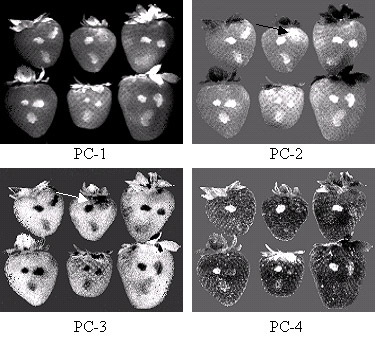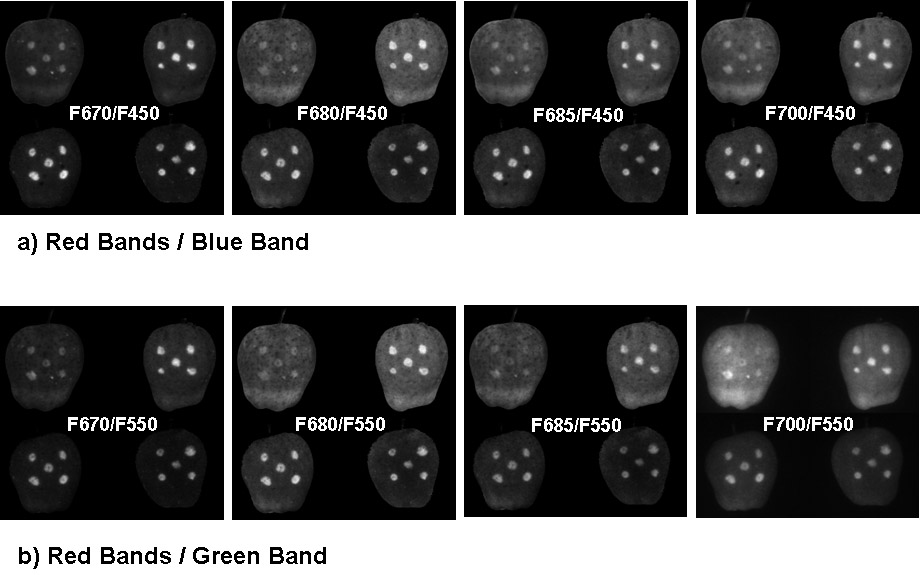|
|
 |
Hyperspectral Analysis of Fecal Contamination Detection on Canteloupes, Strawberries, and Apples
The Food and Drug Administration and United States Department of Agriculture have determined that fecal contamination of produce is a major food safety issue. To determine if detection of fecal contamination on cantaloupes is possible using hyperspectral fluorescence imaging, images were acquired from 415 to 770 nm in response to UV-A excitation. Samples were treated with 10, 20, 30 and 40 l of 1:10, 1:50, 1:100, 1:300 and 1:500 feces dilutions. Images were analyzed using band ratios, unsupervised (ISODATA) classification, and principal component analysis. Results showed that fecal contamination was easily detected in the red band, and that images at 675 nm exhibited the greatest contrast between treated and untreated surface areas. Detection rates were improved using ratio images; the best results were provided by 695/595, 675/555 and 555/665 nm. An unsupervised classification method was effective for reducing false positives and isolating the treated areas. The first six principal component (PC) images exhibited useful attributes for fecal contamination detection. In PC-2 and PC-5 the contrast between treated and normal surface areas was enhanced. PC-5 also differentiated responses of feces from those of damaged tissue, thus, reducing false positives. These results indicate that fluorescence imaging is potentially viable technology for commercial applications for detection of fecal contamination on cantaloupes
.
Spectral imaging has shown potential for assessing quality and safety conditions on produce in a rapid, non-invasive manner. In this study, hyperspectral fluorescence imaging between 425 and 774 nm of artificially contaminates strawberries with bovine fecal matter under Ultraviolet-A excitation were analyzed. Evaluation of the fluorescence spectra and principal component analysis identified 553, 597 679 and 736 nm as optimal wavelengths to classify fecal spots. Visual assessment and fluorescence intensity plots indicated that the image at 679 nm exhibited greatest contrast for all fecal spots concentrations detection. A major impediment in the fecal spot classification process was similar intensity between the spots and the leafy calyx of the fruit. The two-band ratio image at 679/730 nm improved the detection rates by reducing the appearance false positive spots and providing opposite contrast between the surface, the spots and the calyx. Principal Component Analysis (PCA) of the entire spectrum (79 channels) provided differential response for the fecal spots and calyx in the Principal Component (PC) 2 and 3 images. The combined use these two PC images increased the detection rates for all concentrations and decreased the presence of false positives. Results can be improved by using appropriate excitation to increase contrast for fecal matter detection for this produce. This study confirmed the capability of hyperspectral imaging in detecting fecal matter on strawberries and the potential for this method to be use for on-line applications.
Fluorescence techniques have shown great potential for detecting animal feces on foods. A recently developed field portable multispectral fluorescence imaging system was used to acquire steady-state fluorescence images of feces contaminated apples. Twenty Red Delicious apples encompassing natural color variation were artificially contaminated with dairy cow feces to create 5 fecal contamination spots on each apple. The feces spots were not clearly visible to the human eye. Multispectral fluorescence images, with wavebands centered at the red emission peaks of cow feces and apples, in addition to blue and green bands, were evaluated to determine an optimal red band for detection of feces contamination spots on apples. The results show that fluorescence emission bands at 670 nm provided the greatest potential for the detection of feces contamination on apples. In addition, investigation of multispectral fusion methods indicated that band ratio image of 670 nm to 450 nm or 550 nm improve sensitivity of detection. Two-band ratios along with the use of unsupervised histogram-based thresholding allowed detection of cow feces contaminations on apples regardless of apple colorations with a 100% success rate.
|
| [Home] [Biography] [Research] [Teaching] [Industry Exp.] [Lab. Personnel] [Collaborators] [Publications] [Links] |


